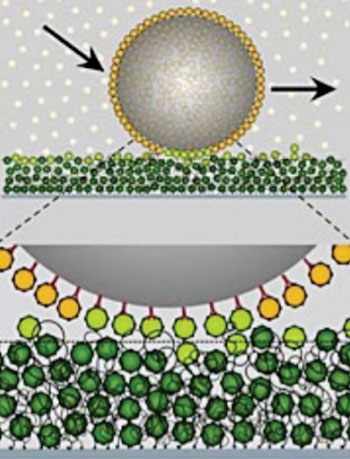Nanoscale Velcro Proteins Discovered to Be Used for Molecule Transport
By LabMedica International staff writers
Posted on 01 Jul 2014
Biologic membranes perform similar to a guarded border. They separate the cell from their environment and at the same time control the coming and going of molecules. The nuclear membrane can be crossed via many tiny pores. Scientists have now discovered that proteins found within the nuclear pore function similar to a “Velcro” snap. They reported how these proteins can be used for controlled and selective transport of particles.Posted on 01 Jul 2014
Scientists at the Biozentrum (Basel, Switzerland) and the Swiss Nanoscience Institute at the University of Basel (Switzerland), together with an international team of researchers, have published online June 15, 2014, in the journal Nature Nanotechnology, they reported how these proteins can be used for controlled and selective transport of particles.

Image: An import protein coated molecule moving on the “dirty velcro” (Photo courtesy of Biozentrum, University of Basel).
Cells are always moving around. Many proteins, for example, need to travel from their production site in the cytoplasm to the nucleus, where they are used to read genetic information. Pores in the nuclear membrane enable their transport into and out of the cell nucleus. Prof. Roderick Lim, from the Biozentrum and the Swiss Nanoscience Institute at the University of Basel, studies the biophysic basics of this transport. To better determine this process, he has created a synthetic model of the nuclear pore complex, working with scientists from Lausanne (Switzerland) and Cambridge (UK), which has led to the discovery that its proteins function similar to a nanoscale Velcro, which can be used to transport tiniest particles.
Nuclear pores are protein complexes within the nuclear membrane that enables molecular exchange between the cytoplasm and nucleus. The major force is diffusion. Nuclear pores are lined with Velcro-like proteins. Only molecules specifically tagged with import proteins can bind to these proteins and therefore pass the pore. But for all nonbinding molecules, the nuclear pore acts as a barrier. The researchers hypothesized that transport depends on the strength of binding to the Velcro-like proteins. The binding should be just strong enough that molecules to be transported can bind but at the same time not too tight so that they can still diffuse through the pore.
In a synthetic system recreating the nuclear pore, the researchers assessed their therapy. They coated particles with import proteins and studied their behavior on the molecular Velcro. Surprisingly, the researchers discovered similarities in behavior to the Velcro strip’s features. On “clean Velcro,” the particles instantly adhere. However, when the Velcro is filled or “dirtied” import proteins, it is less sticky and the particles start to slide over its surface just by diffusion. “Understanding how the transport process functions in the nuclear pore complex was decisive for our discovery,” said Prof. Lim. “With the nanoscale Velcro we should be able to define the path to be taken as well as speed up the transport of selected particles without requiring external energy.”
Prof. Lim’s study of biomolecular transport mechanism form the foundation for the discovery of this amazing phenomenon that particles can be transported selectively with a molecular Velcro. His principle could find very practical applications, for instance as nanoscale conveyor belts, escalators, or tracks, explained Prof. Lim.
This could also potentially be applied to advanced miniaturize lab-on-chip technology, miniscule labs on chips, where this newly discovered approach to transporting would make modern complicated pump and valve systems a thing of the past, according to the scientists.
Related Links:
Biozentrum at the University of Basel
Swiss Nanoscience Institute at the University of Basel




 assay.jpg)









